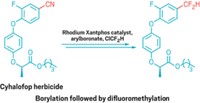Advertisement
Grab your lab coat. Let's get started
Welcome!
Welcome!
Create an account below to get 6 C&EN articles per month, receive newsletters and more - all free.
It seems this is your first time logging in online. Please enter the following information to continue.
As an ACS member you automatically get access to this site. All we need is few more details to create your reading experience.
Not you? Sign in with a different account.
Not you? Sign in with a different account.
ERROR 1
ERROR 1
ERROR 2
ERROR 2
ERROR 2
ERROR 2
ERROR 2
Password and Confirm password must match.
If you have an ACS member number, please enter it here so we can link this account to your membership. (optional)
ERROR 2
ACS values your privacy. By submitting your information, you are gaining access to C&EN and subscribing to our weekly newsletter. We use the information you provide to make your reading experience better, and we will never sell your data to third party members.
Synthesis
New Reagent Brings Fresh Approach To Fluorination
Synthesis: Fluorinated diazomethane serves up key difluoromethyl intermediates for drugs and agrochemicals
by Stephen K. Ritter
May 7, 2015
| A version of this story appeared in
Volume 93, Issue 19

A stream of new methods for introducing fluorine and trifluoromethyl groups into complex molecules over the past decade has created a buzz of excitement among those synthesizing pharmaceuticals and agricultural chemicals.
But new approaches for adding analog groups, such as difluoromethyl, –CHF2, have been scarce. The difference of a single fluorine can impact how easily a molecule can reach its target, how strong an effect it will have, and how long it will remain active.
A new reagent for difluoromethylations, the long-sought compound difluoromethyl diazomethane, CF2HCH=N2, has now been reported by Pavel K. Mykhailiuk of global research chemicals supplier Enamine and Taras Shevchenko National University, both in Kiev, Ukraine (Angew. Chem. Int. Ed. 2015, DOI: 10.1002/anie.201501529). The reagent has already caught the attention of researchers at agricultural chemical companies who are eager to give it a try.
“This new fluorinated diazoalkane will be very useful in synthetic chemistry,” says Guillaume Berthon, group leader for insecticide research at Syngenta Crop Protection, in Switzerland. “While trifluoromethyl-containing heterocycles are routinely introduced in our discovery and optimization programs, the corresponding difluoromethyl heterocycles are seldom explored and could lead to surprising new activity and properties.”
Mykhailiuk drew inspiration for the new reagent from work reported in 2010 by Bill Morandi and Erick M. Carreira of ETH Zurich, who used trifluoromethyl diazomethane for trifluoromethylations. The trifluoromethyl reagent was first prepared in the 1940s. But because it’s a potentially toxic and explosive gas, researchers had not figured out a way to safely take advantage of it. The difluoromethyl analog was in the same boat—chemists had tried to prepare and safely use the reagent for more than 40 years without success, until now.
Mykhailiuk found that refluxing difluoroethylamine with tert-butyl nitrite and a catalytic amount of acetic acid in chloroform generates the new reagent in situ within about 10 minutes. The preparation doesn’t require a catalyst or isolation of the dangerous reagent. To test its reactivity, Mykhailiuk trapped the reagent in a one-pot [3+2] cycloaddition reaction by adding various mono- and disubstituted alkynes. This formed difluoromethylpyrazoles on a gram scale at room temperature without the need for an inert atmosphere.
Mykhailiuk selected the pyrazoles as a target because they serve as the core structure for commercial agrochemicals made by Syngenta, Bayer, and BASF. Mykhailiuk believes the new reagent also will help prepare difluoromethyl-substituted cyclopropanes, ketones, boronic acids, and other intermediates common in organic synthesis.
In agrochemistry, difluoromethyl-substituted pyrazoles have been successful as succinate dehydrogenase enzyme inhibitors that disrupt the metabolism of disease-causing fungi. For example, Syngenta’s isopyrazam fungicide, introduced in 2011, controls diseases in wheat, bananas, and other crops.
“However, there are few reagents and methods that enable the introduction of the –CHF2 functional group into heterocycles,” Syngenta’s Berthon says. “The present paper presents a novel and simple way to make difluoromethyl pyrazoles. I think this work just scratches the surface of what is possible, and I expect this report will be followed by a flurry of papers making new uses of this reagent.”






Join the conversation
Contact the reporter
Submit a Letter to the Editor for publication
Engage with us on Twitter